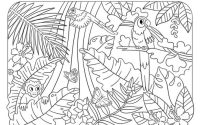Animal Cell Diagram Coloring Page A Fun Learning Tool
Designing a Coloring Page Layout: Animal Cell Diagram Coloring Page

Animal cell diagram coloring page – Creating a compelling and educational animal cell coloring page requires careful consideration of layout and design. The goal is to present the complex structure of an animal cell in a simplified, engaging way that’s easily understood by children. A well-designed page will not only be fun to color but also reinforce learning about cell biology.The key is to balance visual appeal with clarity.
Overcrowding the page with organelles will make it confusing and less enjoyable. Conversely, a sparsely populated page may not adequately represent the cell’s complexity. Strategic placement and the use of color are crucial for achieving this balance.
Organelle Placement and Visual Hierarchy
Effective organization is paramount. Start by selecting the most important organelles to feature – the nucleus, mitochondria, ribosomes, endoplasmic reticulum, Golgi apparatus, and lysosomes are good candidates. Arrange these organelles in a visually pleasing and logical manner. For instance, position the nucleus centrally, as it’s the control center of the cell. Then, arrange other organelles around it, considering their relative sizes and functions.
Think of it as creating a miniature city within the cell; each organelle has its place and purpose. Avoid overlapping organelles excessively, ensuring each one is clearly visible and identifiable. Consider using a circular or slightly oval shape to represent the cell membrane, allowing for even distribution of organelles within the boundary.
Color Coding for Organelles
Using color strategically enhances understanding and engagement. Assign a distinct color to each organelle. For example: the nucleus could be a dark purple, representing its dense chromatin material; mitochondria, crucial for energy production, could be a vibrant red or orange; ribosomes, the protein factories, could be small, dark blue dots; the endoplasmic reticulum, a network of membranes, could be a light blue; the Golgi apparatus, involved in packaging and transport, could be a pale yellow; and lysosomes, responsible for waste disposal, could be a deep green.
This color-coding system helps children associate specific colors with specific functions, improving memorization and comprehension. The cell membrane could be a simple black Artikel, allowing the internal structures to stand out.
Simplified Design for Children, Animal cell diagram coloring page
Simplicity is key when designing for children. Avoid overly complex shapes or detailed illustrations. Use simple, rounded shapes for organelles to make them easy to color. Keep the overall design clean and uncluttered, avoiding unnecessary details that might distract from the main purpose of the learning activity. Consider using bold Artikels to clearly define each organelle’s boundaries.
The goal is to create a coloring page that’s both educational and enjoyable for young learners. A large, clearly labeled nucleus is essential, as it’s the most prominent organelle and plays a critical role in cell function.
Unleash your inner artist with an animal cell diagram coloring page! Dive into the fascinating world of cellular structures, then expand your creativity by coloring the vibrant creatures found in a forest scene – check out these amazing coloring forest pictures with animals for even more fun! Afterwards, you’ll be ready to tackle that animal cell diagram with renewed artistic energy and a fresh perspective!



